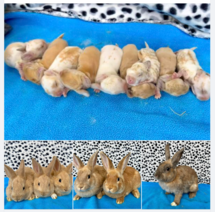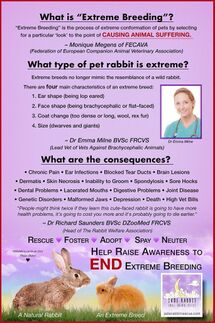Breeding rabbits
Because this is a wiki dedicated to general pet rabbit care, we believe all pet rabbits should be spayed and neutered and not given the opportunity to make more babies. With the amount of rabbits available for adoption in local shelters and rabbit rescues, we do not encourage the casual breeding of rabbits, especially without a responsible plan for the babies that does not encourage dumping intact unwanted rabbits in the streets or in the shelters.
Extreme breeding
Domestic animals such as rabbits, have many different breeds that are all bred for specific traits. Many of which have zero functionality behind these traits besides looking "cute". Some of these traits include, coat density/color, body color markings, snout length, size, and ear length/position. What are some extreme designer breed rabbits?- Jade Rabbit Small Animal Rescue
- Giant breeds - Flemish Giants, Continental Giants, etc. These buns are bred to be excessively large, which can have its consequences such as; arthritis, heart issues, and sore hocks.
- Rex rabbits - Which are bred for their plush dense coat often have no guard hairs like eye lashes to keep debris out of their eye and guard fur on their feet which prevents sore hocks.
- Lop breeds - Holland Lops, French Lops, Mini Lops and English Lops are all bred for their lopped ears. Having lopped ears makes them severely prone to ear infections and having narrow ear canals. Lop breeds are also prone to dental disease due to their shortened snout.
- Flat-faced breeds - Netherland Dwarves, Holland Lops, Lionheads, Dwarf Hotots who are bred for shorter faces to appear "cuter". Due to their shortened face they are prone to dental disease from overcrowding in the jaw, misaligned jaws preventing teeth from properly grinding which results in regular dental trims or teeth extraction all together. Flattened faces can also cause tooth root issues which can block tear ducts and cause abscesses.
- Long-coated breeds - Angoras, Fuzzy Lops, Jersey Wooly and Lionheads. Long coats are prone to matting and require regular grooming to prevent skin irritation and sores. They can also be more likely to have urine scald due to their inability to properly groom themselves. Long coated breeds can also be more prone to hair blockages.
How easily can rabbits mate?

Rabbits can be sexually mature as young as 10 to 12 weeks old. Active mating only requires a few seconds to complete.
Female rabbits can have new litters every 30 to 32 days if bred back-to-back as they can become pregnant again immediately after giving birth. Litter sizes average 5-8 kits, with larger breeds generally having larger litters.[1]
As a result, if you have two rabbits of opposite sexes, it is vitally important that they are kept separate with double fencing until the male is neutered for at least 6 weeks or the female rabbit is spayed. Rabbits may also successfully mate through a single layer of fencing.
When do rabbits ovulate?
Rabbits are reflex ovulators with no regular oestrous cycle. In the domestic rabbit, ovulation occurs about 8 to 12 hours after copulation.[2] Waves of follicles develop and regress on the ovaries and is reflected by periods of receptivity, usually for 12-14 days, followed by 2-4 days of non-receptivity.[3] This can vary, and some does can become receptive every 4-6 days during the breeding season—Jan to Sept in the northern hemisphere.[3] Does are also fertile immediately after kindling, especially during the summer months.[4]
Ovulation can also be induced by mechanical stimulation of the vagina or by the act of being mounted by another female, which can result in pseudopregnancy.[1]
Rescue stories
The following are some stories from rescues about having to step in when a family ended up in over their head with uncontrolled breeding from a few intact rabbits:
- Friends of Rabbits. (2025). ‘Bunny chaos’: More than 60 rabbits rescued from Howard County farm - The rescue never got a straight answer, but they believe the 60+ rabbits they rescued started from a few rabbits "set free".
- McKamey Animal Center. (2024). Chattanooga rabbits - The homeowner had originally had the rabbits separated by gender, but eventually he had a health crisis and it became too difficult for him to keep them separate. The population exploded to over 100 rabbits by the time the rescue arrived.
- Rabbit Rescue of MN & Lily Bun Rabbit Rescue. (2022). Illinois rabbits - a single pair of breeding rabbits multiplied to 57 in the home of a disabled veteran. Many rabbits were injured with missing limbs, ears, eyes, and large abscesses.[5]
- House Rabbit Resource Network. (2021). Creedmoor Bunnies - a single pair of breeding rabbits multiplied to approximately 63, with many not surviving.
- The Rabbit Haven. (2014). Martinez Bunnies - a family with intact rabbits in addition to the nearby area becoming a local rabbit dumping site resulted in a mass rescue of over 100 rabbits.
Further reading
- Dana Krempels. To Breed or Not to Breed?
- Nancy Pinoli. Why We Shouldn't Breed Rabbits
- Amy Shapiro. The Sad Truth About Rabbit Overpopulation
- Holly O'Meara. The Hidden Costs of Breeding Your Rabbit
- Rabbit & Pocket Pet Adoptions. Why shouldn't I breed my rabbit?
- Doris Day Animal Foundation. Please Don't Breed!
See also
References
- ↑ 1.0 1.1 Varga, M. (2013). Textbook of rabbit medicine. (2nd ed.).
- ↑ Lumpkin, S & Seidensticker, J. (2011). Rabbits: The animal answer guide.
- ↑ 3.0 3.1 Keeble, E. & Meredith, A. (2006). Rabbit medicine & surgery: Self-assessment color review.
- ↑ Harcourt-Brown, F. (2001). Textbook of rabbit medicine. (1st ed.).
- ↑ Rabbit Rescue of MN. (2022). Facebook post update on Illinois rabbit rescue. Retrieved 22 Mar 2022 from https://www.facebook.com/RabbitRescueofMN/posts/1088852531959708


